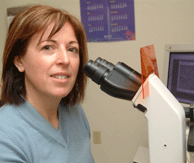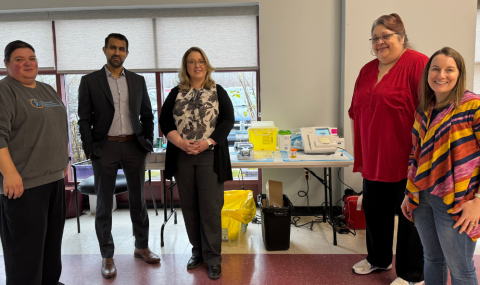Scientist: (formerly) London Regional Cancer Program, London Health Sciences Centre, London, Ontario
Professor: Department of Oncology, University of Western Ontario, London, Ontario
Cross Appointment: Department of Biochemistry
Mailing Address
Verspeeten Family Cancer Centre
Room A4-931A, Cancer Research Laboratory Program
790 Commissioners Rd. E.
London, Ontario
Canada N6A 4L6
Phone: 519-685-8600, extension 53677
Fax: 519.685.8646
Email: eva.turley@lhsc.on.ca
Research Area
Identifying the signaling pathways that regulate cell motility and tumor cell invasion
Laboratory
Our laboratory was the first to show that the extracellular matrix polysaccharide, hyaluronan, directly promotes cell motility by interacting with the surface of cells and that this interaction regulates signaling through non-receptor protein tyrosine kinases such as src. Subsequently, we cloned and characterizated a hyaluronan binidng protein termed RHAMM that mediates many of the motogenic effects of hyaluronan. We showed that RHAMM regulates cell motility and progression through G2M of the cell cycle and that it is required for both hyaluronan and PDGF-mediated activation of erk kinase. Some protein forms of RHAMM bind directly to erk 1 kinase and this interaction as well as the binding to hyaluronan is required for activation of erk in response to growth factors.
Related to this function of RHAMM, we and others have shown that RHAMM is overexpressed in many human cancers and this hyper-expression is prognostic of poor patient outcome for colo-rectal, stomach and breast cancers. We have developed RHAMM -/- mice and are currently using these lines, together with RHAMM-/- X CD44-/- mice to assess the role of RHAMM and CD44 in murine models of tumor progression and various response to injury processes.
Staff and Trainees
Research Associates:
Dr. Conny Toelg, Research Associate
Project: Regulation of microtubule stability by RHAMM
Email Dr. Conny Toelg
Natalia Akentieva, Research Associate
Project:
Email: Natalia Akentieva
Pat Telmer, Postdoctor Fellow
Project:
Email: Pat Telmer
Undergraduate Students:
Colleen Nicole Biggs, Research Assistant
Project:
Email: Colleen Nicole Biggs
Caitlin Ward, Research Assistant
Project:
Email: Caitlin Ward
Rashmi Nedadur, Co-op Student
Project:
Email: Rashmi Nedadur
Sonam Maghera, Co-op Student
Project:
Email: Sonam Maghera
Siddika Pardhan, Co-op Student
Project:
Email: Siddika Pardhan
High School Student:
HaoLian Quan, Co-op Student
Email: HaoLian Quan
Research Technician:
Jenny Ma, Research Technician
Project: Various
Email: Jenny Ma
Summary of Current Work
Research is focused on identifying the signaling pathways that regulate cell motility and tumor cell invasion, in particular, factors that contribute to breast cancer progression.
The connective tissue environment of cells is increasingly appreciated to play a key role in the proliferation and spread of cancer and in a number of human diseases that result from immune responses that have gone awry. This laboratory studies the role of one of the components of connective tissue, a sugar called hyaluronic acid, in regulating the cancerous state of cells. As a result of previous studies in this laboratory, a protein that binds this sugar to cells (termed "RHAMM") has been identified and its ability to regulate the migration and proliferation of connective tissue cells and cancer cells demonstrated. Currently, studies are underway to identify the molecular mechanisms by which RHAMM regulated motility and invasion of cancer cells. In addition, the role that this protein plays during wound repair is being assessed. Finally, we are collaborating with several groups to improve targeting of therapeutic reagents to breast cancer cells.
Current Projects
- Identifiction of the mechanisms and conditions RHAMM can be exported from the cell
- Assessment of the consequences of genetically deleting RHAMM on wound repair and tumor formation in appropriate murine models
- Identification of the intracellular signaling pathways that RHAMM regulates and assessment of the relative contribution of cell surface vs. intracellular RHAMM forms to this regulation
- Identification of genes related to both wound repair and tumor invasion that are regulated by RHAMM/HA interactions
- Documentation of additional protein partners for both cell surface and intracellular RHAMM forms
- In collaboration with other groups we are using these mice to assess the role of both hyaluronan binding proteins in mammary gland morphogenesis, stem cell generation, and skin wound repair
- In collaboration with other groups, we are assessing the use of hyaluronan for targeting drugs including anti-sense DNA, to tumor cells



